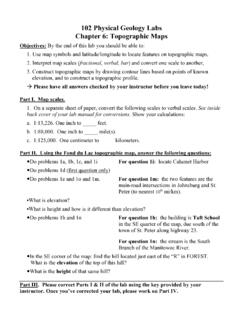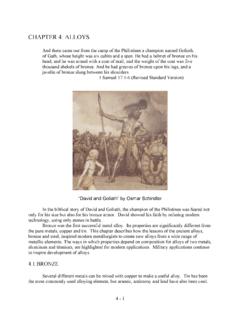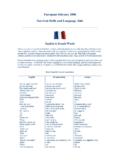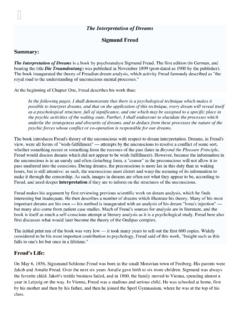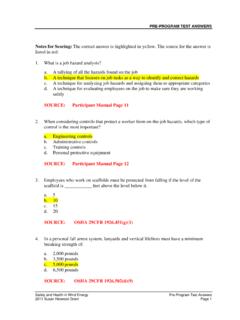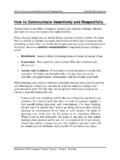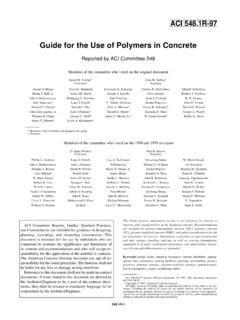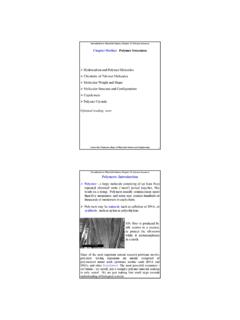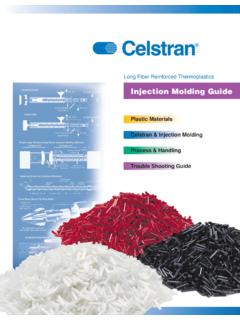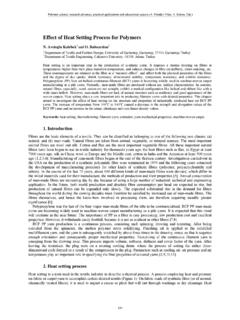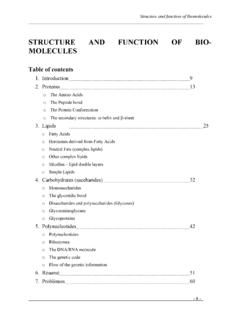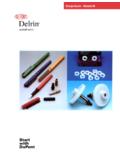Transcription of CHAPTER 1: CLASSIFICATION OF MATERIALS
1 1 - 1 chapter 1: CLASSIFICATION OF MATERIALS A day at the park WHY STUDY MATERIALS ? On a sunny day at the park, where would you prefer to sit and relax - on a wooden bench, stone pedestal, concrete sidewalk, or grassy lawn? It probably depends on if you want to be warm or cool. If you want to read, be thankful that you don't have to carry carved stone tablets or a parchment scroll; you can carry a paperback book in your backpack or download an ebook to a portable computer. Maybe you should take a jacket along. Which would be the best choice - a wool blazer, nylon windbreaker, microfiber trenchcoat, or cotton sweatshirt? People who are fortunate enough to have all of these in their closets can choose the material that best protects them from the predicted weather - temperature, precipitation, and wind.
2 In modern society we are surrounded by an amazing variety of MATERIALS . Most of the MATERIALS discussed in this book are solids that have been modified from their natural states to make them more suitable for practical applications. The MATERIALS people use have such an impact on their lifestyles that historical eras have 1 - 2 been named for them. Ancient artifacts found by archaeologists have been dated and analyzed to reveal the increasing sophistication of their manufacturing methods. Early humans Stone age ~9000 BCE Copper age ~3000 BCE Bronze age ~1200 BCE Iron age Artifacts of civilization top row: flint handaxe, copper coin, bronze helmet bottom row: locomotive wheel, plastic toy, solar cell Historians have shown that technological advancements created new tools for agriculture and new weapons for armies.
3 Explorers established trade routes to redistribute raw MATERIALS and finished products. Modern culture is also influenced by the availability of new MATERIALS . In the 1960's plastics were used to make colorful toys and housewares at such a low cost that they were frequently disposed of and replaced with the latest style. In the 1980's silicon based electronics started spreading through businesses and homes. Since the 1960s homes (and landfills) in the United States have become bigger and more crowded with objects for applications never dreamed of by stone age humans. In the 21st century there is much discussion of "globalization." MATERIALS definitely follow a global cycle. Raw MATERIALS are collected; processed into useful MATERIALS ; sold to consumers; and eventually discarded as waste.
4 Each stage may occur on a different continent! Supply and demand of MATERIALS can affect international relations. 1 - 3 WHY STUDY THE CHEMISTRY OF MATERIALS ? A standard place setting includes metal cutlery, a polymer napkin, and a ceramic dish. Traditionally the three major classes of MATERIALS are metals, polymers, and ceramics. Examples of these are steel, cloth, and pottery. These classes usually have quite different sources, characteristics, and applications. Chemists have learned that the macroscopic (visible) properties of matter are related to its microscopic (invisible) composition and structure. The atoms and molecules that compose matter are too small to see. But if we know what something is made of, and how it's held together, then we can break it apart and rearrange it.
5 The result can be something with totally different properties. Nylon is made from oil! HOW CAN WE COMPARE MATERIALS ? Performance Physical & Chemical Properties Composition & Structure Processing & Synthesis These four categories are useful ways to sort different MATERIALS . Metals, polymers and ceramics tend to have great differences in these categories. Each category will be briefly discussed here, then used in later chapters to highlight the special qualities of each material . PERFORMANCE The performance of a material is discussed in the context of an application. For example, many MATERIALS are used for building houses. Once upon a time, three little pigs and a big bad wolf did an experiment to find out if a house should be made of straw, sticks or bricks.
6 1 - 4 Comparison of ceramic and polymer building MATERIALS When the wolf huffed and puffed, the straw and stick houses fell down. Brick had the best performance. However in an earthquake, the brick house would be the worst place to be! The vibrations can rattle the bricks apart. California s building codes favor wood or steel-reinforced concrete. What should a good house material do? Protect the things inside from weather - wind, cold, heat, rain, snow, hail - and from fire. A medieval castle was designed to withstand cannonballs but since that is not usually a concern in modern construction, most people would decide that its superior performance is not worth the extra cost. PROPERTIES To choose a material with the best performance for a particular application, we will need to consider the properties of the available MATERIALS .
7 Properties are the observed characteristics of a sample. Physical properties Some physical properties describe how an object responds to mechanical forces. Hardness is one example of a mechanical property. If you drag a steel knife blade across a hard object, such as a plate, the hard surface is unchanged; if you drag the blade across a soft object, such as a piece of chalk, the soft surface will be scratched. An object is tough if force is unable to break or tear it. The response to force depends on the material 's structure, and also on its shape and size. A piece of notebook paper can be torn easily, but a telephone book requires much greater force. We can easily bend a flexible object such as a nylon jacket, but more force is required to bend a stiff object like a polyethylene milk jug.
8 If an object returns to its original shape and size when the force is removed, we call it elastic. If the deformation remains, it is plastic. An object that breaks rather than bending is brittle. 1 - 5 An object is strong if an applied force is unable to deform or break it. A nylon windbreaker is strong, since pulling on it does not change its length. Sometimes the manner of applying a force makes a difference to the strength of an object. Ceramics can bear a lot of weight, but will break if stretched or bent. Nylon survives compression, pulling and twisting. Color, texture, and reflectivity can be observed by shining light on a sample. Mirrors are colorless, smooth, and shiny. Electrical conductivity is detected by applying a voltage across an object. Applying heat to a sample reveals its ability to conduct heat, its melting point (temperature at which a solid changes to liquid), and its boiling point (temperature at which a liquid changes to gas).
9 Some properties are independent of the amount of sample. Melting point does not change if a sample is divided in half. Other properties, including mass and volume, increase with the amount of sample being studied. When observing properties in a laboratory, scientists use the Metric System of measurements. The basic units of the Metric System are presented in Appendix I. Mass is measured on a balance or scale. A ruler can be used to find the volume of a regularly shaped object. A staple is just over 1 cm long. Two paper clips have a mass of about 1 gram. widthlengthheightVolume = length x width x height 1 - 6 5 mLvolume of liquid = mLvolume of liquid + object = mLvolume of object = difference = mL5 mL Displacement of liquid in a graduated cylinder is a method that will work for irregularly shaped objects.
10 Some interesting properties are not measured directly, but can be determined by combining measurements of other properties. Density is a characteristic property of a material and can be a good way to identify an unknown sample. It is usually calculated from the mass and volume of a sample. density = mass / volume or d = m / V Example: A block of wood measures 2 cm by 1 cm by 5 cm. Its mass is g. What is its density? The volume is 2 cm x 1 cm x 5 cm = 10 cm3 = 10 mL. The density is g / 10 mL = g/mL Most solids have densities greater than g/mL, but there are exceptions; anything that floats on water (such as wood) has a density less than g/mL. Although a chunk of alumimum will sink in water, aluminum foil can be shaped to create an object of greater volume that floats.
